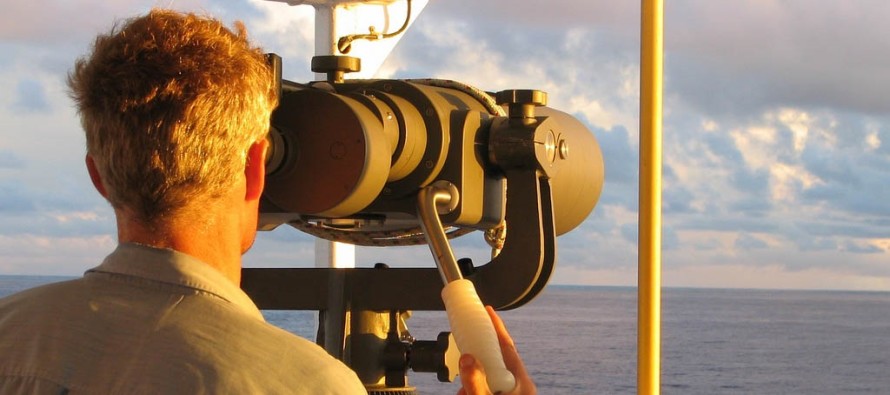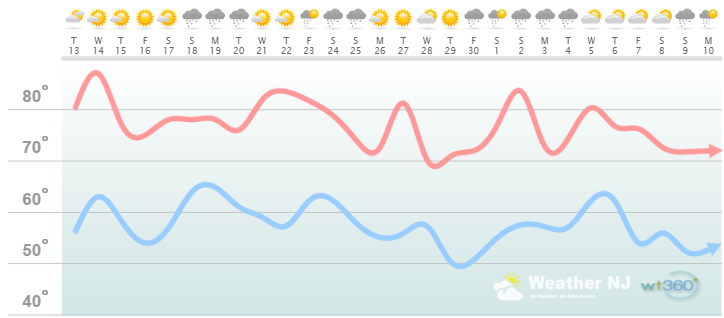Long Range Outlook: Closing Out September 2016

It’s time to harness the WeatherTrends360 proprietary weather algorithms to see how the rest of September 2016 should play out. But first lets break New Jersey into proper climatological regions. We have the higher elevations of NNJ/NWNJ, the interior coastal plain (SWNJ through CNJ and into NENJ), and the coastal regions (most of SENJ). I’ll be representing each climatological region with a 28-day graph from weathertrends360 data followed by a brief discussion. Please keep in mind that these algorithms are documented with an 84% verification rate and are based on oceanic water cycles and time table series. The best takeaway from this are general trends (cool vs warm, rainy vs dry, etc). That’s what WeatherTrends360 does best with their proprietary mathematical analysis derived from over 150 years of reactive pattern data.
Higher Elevations of NNJ/NWNJ
(Sussex, Warren, Hunterdon, Morris, N. Somerset, and N. Passaic) – Known for little to no Atlantic Ocean influence, colder-snowier winters, and drier conditions in general when compared to the coast. This region is known to get hot when high pressure sits overhead during the summer and bitterly cold during Arctic outbreaks in the winter. Elevation is a major influence that separates this micro-climate from the rest of New Jersey. This region extends into NE PA (Poconos) and parts of NY State (Catskills).
Higher Elevation Discussion: September looks like a slow and steady decline of high and low temperatures. Nothing really crazy jumping out other than a few dips heading into this weekend and around the end of the month. These dips would be days where highs fail to escape the 60s and lows drop into the 40s. Otherwise, I’m seeing plenty of beautiful days scattered between a few periods of widespread rainfall which is much needed.
Interior Coastal Plain from SWNJ-CNJ-NENJ
(Salem, Gloucester, Camden, W. Burlington, Mercer, W. Monmouth, Middlesex, S. Somerset, Union, Essex, Hudson, Bergen, and S. Passaic) – Known for naturally higher temperatures due to lower elevations away from the oceanic influence. This region is also known as “heat island” due to transportation (I-95 corridor), smog, abundant asphalt, concrete, and other man-made substances that naturally absorb and retain heat moreso than natural protected land. This is why excessive heat warnings and air quality alerts are more common in this region. SWNJ always tends to run a few degrees warmer than NENJ but this region is very similar otherwise in micro-climate due to the parallel nature of the Appalachian Mountain elevations to the NW. The same micro-climate can be extended into SE PA and NE MD which tends to run just a little stormier than NJ. This however is what makes up the interior coastal plain.
Interior Coastal Plain Discussion: September looks like a slow and steady decline of high and low temperatures. Nothing really crazy jumping out other than a few dips heading into this weekend and around the end of the month. These dips would be days where highs just break into the 70s and lows flirt with dropping into the 40s. Otherwise, I’m seeing plenty of beautiful days scattered between a few periods of widespread rainfall which is much needed.
Coastal Regions of SENJ
(Cumberland, Cape May, Atlantic, E. Burlington, Ocean, and E. Monmouth) – Known for tremendous influence from the Atlantic Ocean. Oceanic influence keeps this zone cooler in the summer and warmer in the winter than the interior coastal plain and especially the higher elevations of NWNJ. In the summer, sea breeze fronts back into the coast and can ignite thunderstorms if enough instability is present. The cooler marine air slides under the hot air to the W and provides additional atmospheric lifting. This is both why it’s 5-15 degrees cooler at the shore than the Philly-Trenton area and why near-stationary thunderstorms can form along the coast capable of producing localized flash flooding. In the winter, the ocean is warmer than interior regions which plays a huge role in rain vs. snow—highly dependent on wind direction. When the winds chance from NE to N/NE, that’s usually when temps crash and change rain over to snow. Regardless, this micro-climate is well known, well documented and well expressed. This region extends into most of Delaware as well.
Coastal Region Discussion: September looks like a slow and steady decline of high and low temperatures. Nothing really crazy jumping out other than a few dips heading into this weekend and around the end of the month. These dips would be days where highs just break into the 70s and lows flirt with dropping into the 40s. Otherwise, I’m seeing plenty of beautiful days scattered between a few periods of widespread rainfall which is much needed.
Hurricane season is now at it’s peak and will remain decline in October. We started off with an active September but activity has since died. Should anything re-emerge as a potential threat, I’ll be on it. We’re about 6-8 weeks until we’re out of the woods and onto nor’easter season.
In English: The rest of September is looking pretty average regarding temperatures and precipitation chances. The second half/third of the month (starting around the 18th-forward) should feature more rainfall than the first half which will be much welcomed and needed. Nothing major on the horizon as of now.
Weathertrends360 is a complete, global, web solution to help retailers and suppliers capitalize on the weather and its influence on sales and marketing plans up to a year ahead. Learn how to become PROACTIVE vs REACTIVE with the weather in every phase of your business – how much inventory to buy/produce, where to allocate more/less, when to run weather-optimized advertising/marketing campaigns – weathertrends360 can help you determine all of this in minutes! 84% independently audited accuracy for both short-term and year-ahead forecasts for temperature and precipitation.
A forecast Weather Trends issued one year ago is more accurate than every other weather company’s 5 to 14-day forecasts. The University of Miami and West Point PhD Climatologist’s prove WTI’s year-ahead forecasts are several times more accurate than NOAA – Click to Download Report. Also check out their free txt and email alerts!
Have a great rest of your September and please be safe! JC
Image Credit: NOAA
Jonathan Carr (JC) is the founder and sole operator of Weather NJ, New Jersey’s largest independent weather reporting agency. Since 2010, Jonathan has provided weather safety discussion and forecasting services for New Jersey and surrounding areas through the web and social media. Originally branded as Severe NJ Weather (before 2014), Weather NJ is proud to bring you accurate and responsible forecast discussion ahead of high-stakes weather scenarios that impact this great garden state of ours. All Weather. All New Jersey.™ Be safe! JC












